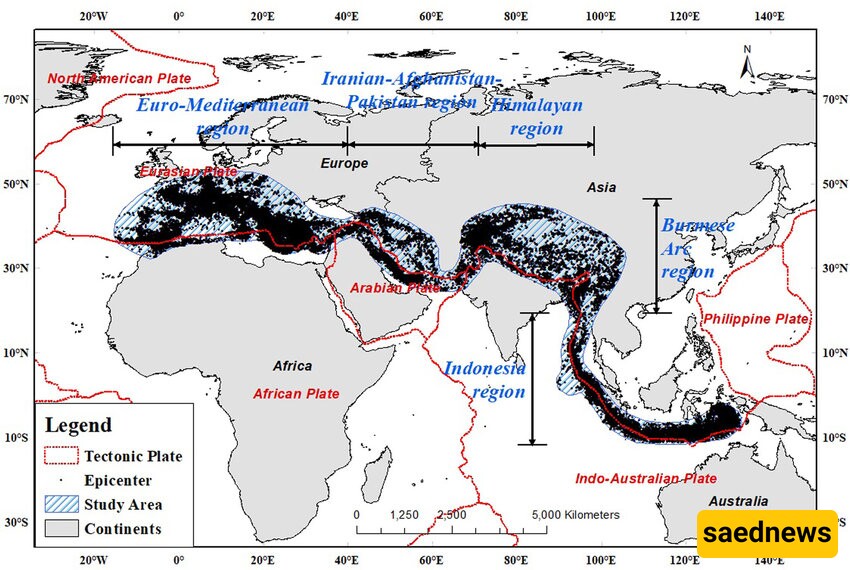SAEDNEWS: This blog post explores the world's major earthquake zones: The Ring of Fire, The Alpide Belt, and the Mid-Atlantic Ridge. By understanding these regions' tectonic behaviors, we can better prepare for seismic events and safeguard our communities against natural disasters.

According to SAEDNEWS, Have you ever felt the ground shake beneath your feet and wondered, “Where do most earthquakes occur?” Earthquakes are unpredictable events that can hit any corner of our planet, at any given moment. Yet, some regions are significantly more susceptible to seismic activity than others. In this post, we’ll delve into three of the most seismic hotspots on Earth: The Ring of Fire, The Alpide Belt, and the Mid-Atlantic Ridge. By understanding these regions and the tectonic processes at play, we can gain insight into why these natural phenomena occur and how to prepare for them.
The Earth’s outermost layer, or crust, is composed of several large, interconnected tectonic plates that float atop the semi-fluid mantle below. These plates can shift, collide, or slide against one another, causing stress in the crust that ultimately leads to earthquakes. While seismic activity is most prevalent along the edges of these tectonic plates, eruptions are also triggered by movements along fault lines—cracks in the Earth's crust where stress builds up over time.

The Ring of Fire is a massive area that encircles the Pacific Ocean and is responsible for approximately 81% of the world's largest earthquakes. Spanning around 24,900 miles (40,000 kilometers), this region initiates in Chile and sweeps north along the coasts of the Americas, through Alaska, and across the Pacific Islands, ending in New Zealand. Famous for its high volcanic activity, the Ring of Fire boasts 452 volcanoes, including Mount Fuji in Japan and the Andes in South America.
Some notable seismic events include the 1960 Valdivia earthquake in Chile, which registered a staggering magnitude of 9.5, and the 2011 9.0 magnitude tsunami-inducing earthquake in Japan. These catastrophic events highlight the Ring of Fire’s potential dangers, reinforcing the importance of earthquake preparedness in the region.

Another significant seismic region is the Alpide Belt, spanning approximately 9,300 miles (15,000 kilometers) from the Indonesian islands to the Mediterranean Sea. Home to some of the world's most renowned mountain ranges, including the Himalayas and the Alps, the Alpide Belt experiences about 17% of global seismic activity. The ongoing collision of the Indian, Arabian, and African plates with the Eurasian plate produces catastrophic earthquakes, such as the 2004 Indonesian earthquake and the 2023 Turkey-Syria quake, which together have claimed hundreds of thousands of lives.

Stretching approximately 10,000 miles (16,000 kilometers) beneath the Atlantic Ocean, the Mid-Atlantic Ridge marks the dividing line between the Eurasian and North American plates to the north and the African and South American plates to the south. While it primarily lies underwater—which minimizes human impact—this divergent boundary still generates tectonic activity, causing occasional earthquakes. Iceland, situated directly atop this ridge, experiences frequent seismic events, reminding us that even less visible faults can be deceptive.
While some regions are rife with seismic activity, a handful of countries enjoy relative safety from earthquakes. Nations like Chad, Niger, and Finland have minimal historical earthquake risks, making them more stable locations for residents concerned about seismic events.

Though it's impossible to predict precisely when or where an earthquake will occur, understanding the geological dynamics of high-risk areas helps us prepare better. The Ring of Fire, the Alpide Belt, and the Mid-Atlantic Ridge each expose different geographical and tectonic characteristics that shape our world. As we gain knowledge about these seismic hotspots, we empower governments and individuals with the tools to enhance safety and prevent needless loss during natural disasters.

